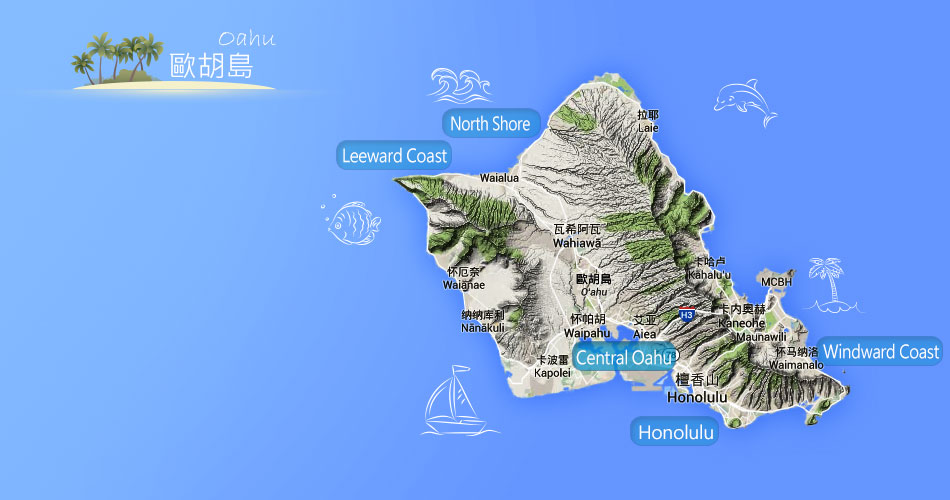- Travel Guide
- 〉
- Oahu
Oahu Experiences
Home to the majority of Hawaii’s population, the state capital of Honolulu and world famous Waikiki, Oahu is often the first stop for visitors to Hawaii. Flights arrive at Honolulu International Airport (HNL), Hawaii’s major airport and the entry point for most of Hawaii’s visitors, roughly 20 minutes from Waikiki. All major domestic carriers and many international carriers serve Oahu, so you can get here from just about anywhere. You’ll find the majority of hotels and resorts in Waikiki, but you’ll also find three renowned Oahu resort areas on the North Shore, the Leeward Coast and in the Kahala area of east Honolulu.
About Oahu
Sometimes called “The Gathering Place,” Oahu certainly lives up to its name. The third largest Hawaiian island is home to the majority of Hawaii’s diverse population, a fusion of east and west cultures rooted in the values and traditions of the Native Hawaiian people. It’s this fundamental contrast between the ancient and the modern that makes discovering Oahu so enjoyable.
Oahu Geography & Maps

Oahu is separated into 5 main areas: Honolulu, the North Shore, the Windward Coast, Central Oahu and the Leeward Coast. Note that world-famous Waikiki is actually a neighborhood located in greater Honolulu. Oahu occupies 597 square miles and is the second oldest of the six Islands of Aloha, lying between Kauai and Maui. Oahu is made up of two major mountain ranges that were once shield volcanoes that are now extinct. These two mountain ranges – the Waianae range to the west and Koolau range to the east – run almost parallel to each other. Over a hundred ridges extend from the spines of each range creating beautiful valleys and stunning mountain vistas.
Oahu FAQs
● Do I need a car to get around Oahu?If you’re planning to stay in Waikiki, you can get around by shuttle, tour bus, taxi, or Hawaii’s excellent public transportation system. But to really experience Oahu outside of Waikiki, you should consider renting a car.
●Where are the major hotel and resort areas on Oahu?Most Oahu resorts and hotels can be found in Waikiki. You can also find luxury resorts in east Honolulu, the North Shore, and the Leeward Coast.
●What should I pack on my trip to Oahu?It’s warm on Oahu, so pack your summer attire. You may want to bring a light jacket or sweater for the evenings.
●When is a good time to visit Oahu?Anytime of year is a good time to visit Oahu. The average temperature here is between 75˚-85˚ F. Summer, between April and November is warmer and drier while winter, between December and March, is a bit cooler. Trade winds keep things comfortable year-round. Winter is big wave surf season on Oahu’s North Shore with major competitions in November and December. Whale watching season begins in December and ends in May. Peak whale watching months are between January and early April.
●How far is it from Waikiki to Oahu’s attractions?
-
From Honolulu International Airport to Waikiki 9 miles / 30 minutes
-
From Waikiki to Pearl Harbor 11 miles / 30 minutes
-
From Waikiki to Downtown Honolulu 4 miles / 15 minutes
-
From Waikiki to Polynesian Cultural Center 35 miles / 75 minutes
-
From Waikiki to Haleiwa Town (North Shore) 32 miles / 60 minutes
-
From Waikiki to Nuuanu Pali Lookout 11 miles / 30 minutes
- From Waikiki to Ko Olina 26 miles / 45 minutes
Oahu Weather
Oahu is generally drier on the Leeward Coast (west) and wetter and greener on the Windward Coast (east). The resort area of Waikiki and the surfing mecca of the North Shore offer pleasant weather year round. There are generally two seasons on Oahu. Winter (November through April), when temperatures typically range in the low-70s to mid-80s, and summer when the high can run into the low-90s. Average air temperature ranges from 74 degrees F (23 degrees C) to 88 degrees F (31 degrees C) with moderate humidity of 53% during the day. Gentle trade winds keep even the warmest months comfortable, so any time of year is a good time to visit Oahu.
Oahu History
From the Hawaiian monarchy to the attack on Pearl Harbor, an exploration of Oahu’s history reflects the key influences that have impacted all of Hawaii. In 1795, King Kamehameha I led his forces in the legendary Battle of Nuuanu near the scenic precipices of the Nuuanu Pali Lookout. This pivotal battle resulted in the conquering of Oahu and the eventual unification of the Hawaiian Islands under one rule in 1810.
Seven Hawaiian monarchs followed after Kamehameha the Great. King Kamehameha III (Kauikeaouli) permanently established the Hawaiian Kingdom’s government on Oahu. King Kamehameha IV (Alexander Liholiho) and his wife Emma’s summer retreat, the Queen Emma Summer Palace, can still be visited in Honolulu’s Nuuanu Valley today. King Kalakaua, also known as the Merrie Monarch, built the majestic Iolani Palace in Downtown Honolulu. Queen Liliuokalani was Hawaii’s last reigning monarch after American colonists overthrew the Hawaiian Kingdom in a controversial coup in 1893. In 1898, Hawaii became a territory of the United States.
In 1959, Hawaii became the 50th state of the United States. Completed in 1969, the Hawaii State Capitol is located in Downtown Honolulu, behind Iolani Palace. From the largest museum in the state, Bishop Museum, to the Pearl Harbor Historic Sites, Oahu is home to numerous landmarks and significant points of interest that shed light on the fascinating facets of Hawaii’s past.






